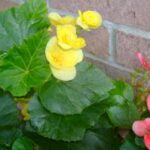Begonia is in the flowering plant family Begoniaceae. There is one other member of this family called Hillebrandia with a single species found in the Hawaiian Islands. There are over 1,500 species making Begonia one of the ten largest angiosperm genera. Only a small fraction is under cultivation. Begonias are particularly easy to hybridize so there are many more of them grown than species. Leaves are often large with various marks or variegated. The leaves are usually asymmetric or unequal-sided.
The American Begonia Society classifies begonias into several major groups that include:
Canes
Shrubs
Tuberous
Rhizomatous
Semperflorens
Rex
Trailing-scandent
Thick-stemmed
The different groups have different cultural requirements. Most begonia species come from tropical regions and require warm temperatures. Most are grown as forest understory plants and require bright shade. Very few begonias tolerate full sun especially in warmer areas. Begonias usually require a well-drained growing medium that is neither continually wet nor allowed to dry out completely. A lot of begonias will grow and flower year-round; however, tuberous begonias usually have a dormant period. During this dormant period the tubers can be stored in a cool and dry place.
Types of Begonias
Canes
The cane begonias are popular plants and were also called “Angel Wing” begonias. Cane begonias have several types of canes in varying sizes. The one thing they all have in common is tough stems that have a bamboo appearance giving them the cane handle.
Shrubs
The shrub type can range in size from miniatures to giants 12 feet tall. Some leaves of the shrub type have a smooth shiny appearance while other types have hairy or felted appearances. The shrub type gets its name from how it grows with many shoots coming up from the soil making a full plant like any other shrub. Shrub type has many stems. Many varieties do not bloom as often or as heavily as the cane type, however, there are many that do bloom and are used as bedding plants across the country. The shrub type is easy to grow and has interesting leaves. Most shrubs have white flowers; however, pink and red ones are fairly common as well. They have many hairy flowers.
Rhizomatous
The Rhizomatous type is grown mostly for their interesting leaves and compact growth. They also display a massive array of flowers usually in the spring. The flower display covers the entire plant. There are few that bloom all year. Sizes range from tiny miniature to large plants, as large as those having 3 foot leaves under optimum conditions. The plants can grow very large across. They do not reach a great height because they grow from rhizomes that stroll along the ground. Some types of rhizomatous have intricate patterns on their leaves in various earthly tones and silver. You will see hairy leaves, round and shiny leaves and some star shaped leaves. This type has a wide variety of leaf shape, color and texture.
Semperflorens
The Semperflorens is probably the most widely grown begonia. It is called “wax type” in some parts of the country due to the waxy look of the leaves. They are grown mostly as bedding plants and annuals; however, they are really a perennial shrub type in climates that do not experience freezing temperatures. All Semperflorens have round leaves and are forever blooming. The flower colors come in many shades of red, pink and white. The leaves are most often seen in two colors of green and bronze. There are variegated types such a B. ‘Charm’ and calla types with new leaves that come out white. Flowers bloom in single and double types. Some specie has felted white or brown leaves.
Tuberous
This type is very popular around the world as a bedding and greenhouse plant. In England it is the main type of begonia grown. The tuberous type produces mostly flowers, although there are a few varieties and species having interesting leaves and growth. Flower size can range from ½ inch to the large exhibition types having flowers the size of dinner plates. Flower size range from singles to full doubles. They come in a variety of colors with the exception of blue. Some flowers have different color edges and some are even scented. Plant types range from trailing types that are grown in hanging baskets to pendulant flowers grown as sturdy upright plants. They grow from tubers and lie dormant during short days in fall and winter. They are restarted in the spring.
Rexes
The showboats of the begonia world are Rex Begonias. They are a type of rhizomatous begonia that is grown for their multicolored leaves. The leaves grow in every color, pattern, size and shape.
Trailing/Scandent
This type can grow a spectacular show of flowers; however, they are grown mostly for the trailing habit. Some newer varieties have a longer blooming period or are ever blooming. Most trailing/scandent have glossy leaves that look like a philodendron. There are other types that grow large leaves that will climb. In their native climates these types will climb up the trunks of trees. Most trailing types grow white or pink flowers.
Thick-stemmed
These come in various forms and are not as widely grown as some of the other types. They have the common factor of very thick stems. Most of this type do not branch out but sends up new growth from the base. The type is a good example of the thick stems because they drop their lower leaves on the tips. If you are looking for something different, these can be very attractive and unusual.
Source:
http://en.wikipedia.org/wiki/Begonia
http://www.begonias.org/greenhouse

